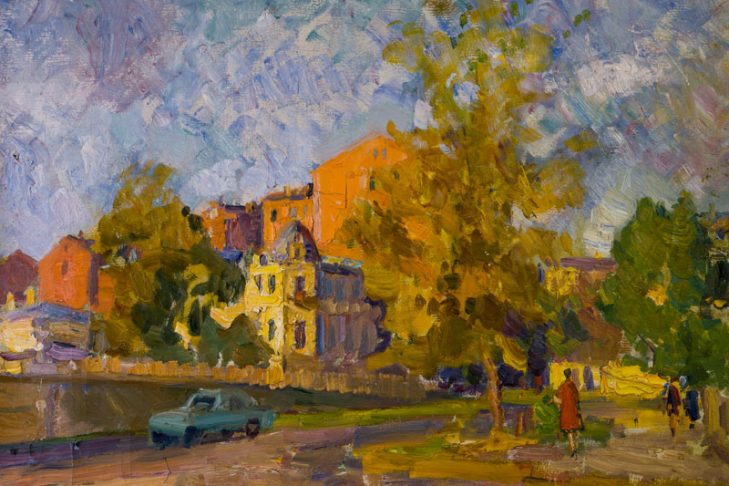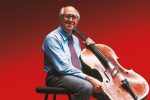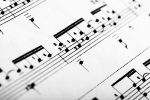The names of some of the 50 artists whose work comprises a new art exhibit called “Migration & Memory: Jewish Artists of the Russian and Soviet Empires” may not be immediately recognizable. But these 100 works, on display at the Museum of Russian Icons and drawn from the vast paintings and works on paper of the Vladimir and Vera Torchilin Collection, present a compelling aspect of the history of the Soviet Union through art.
Timed to coincide with the centenary of the October Revolution of 1917, the show includes pieces by Eugene Berman, Sonia Delaunay, Moshe Kogan, Anatoly Kaplan and others. The exhibit’s curator, Anna Winestein, observes that the inspiration for the show was not only the centenary, but also “the transformative influences that the Revolution had for Jews in Eastern Europe and within the Soviet Union.”
The Torchilins’ art collection arrived in the United States a few years after they immigrated to Massachusetts from the Soviet Union in the early ’90s. The couple was able to return to Russia and bring out a portion of Vladimir’s parents’ collection as well as works they owned. According to Winestein, the couple has continued to add “voraciously” to their personal collection over the years. “A lot of the paintings in the show,” notes Winestein, “were assembled by the Torchilins in America and Europe, making it an evolving, living thing as all collections are.” She adds that the Torchilins have one wall in their home exclusively dedicated to Jewish artists. “It’s a way of paying tribute to their heritage [Vladimir is Jewish] and of showing that there are many different facets of what it means to be Jewish,” she says.
Winestein, who is the executive director and co-founder of the Ballets Russes Arts Initiative, which she describes as “a Boston-area non-profit that follows in the tradition of Diaghilev’s Ballets Russes by promoting international creative exchange in the fine and performing arts, especially with the post-Soviet region,” is a Ph.D. candidate in modern history at Oxford University. Her scholarly interests include a focus on the art and theater of the Russian and Soviet empires up to World War II, as well as the emigration of Soviet artists to Europe and the United States during that same time. Winestein points out that many of the artists and performers who left the Soviet Union before World War II were Jewish. Winestein, who was born in the Soviet Union, asserts: “I’m interested in how the culture and heritage of the Eastern European sphere of influence connect to the West. Working with this collection has made me look at the entire 20th century of Russian art.”
-
Perhaps almost as fascinating as the show is the venue where it will be shown. The Museum of Russian Icons is in Clinton, a small, central Massachusetts town, which was once a mill town and home to Nypro—an international injection molded plastics company. Gordon Lankton, the former CEO of Nypro and an avid collector of Russian icons, founded the museum, which opened in 2006.
Lankton’s personal Russian icon collection began with a single purchase in 1989 at a flea market in Russia. Over the past two decades, he has acquired over 1,000 icons. Looking for a place to house his growing collection, Lankton renovated a 150-year-old former mill as well as an adjacent police station and former courthouse, both also over a century old. Lankton located his museum in Clinton as a way to thank the community in which he was deeply invested. The museum is the only one of its kind in the United States and houses the largest collection of Russian icons outside of Russia. It welcomes up to 15,000 visitors a year from all over the world.
A museum devoted to religious icons connected to the Russian Orthodox Church may seem like an unusual place to exhibit Russian-Jewish art. The choice of space, however, was deliberate. The museum and the Torchilins see the exhibit as a concerted effort to reach out to the Russian-Jewish community. Winestein confirms that, “when I pitched [the idea of exhibiting the Torchilin collection] to the museum, they were very intrigued. The tendency in the Russian-Jewish community is not to be interested in icons even though the museum is a secular institution, which celebrates icons as art and historical objects. Presenting part of the Torchilins’ collection was a very interesting opportunity.”
As of this writing, the exhibit is not scheduled to travel to another venue after its current run. However, Winestein has been in talks with curators and collectors in England who are interested in mounting a more extensive show of the collection. Winestein says the current exhibit may also be a first step “to a larger-scale project that would go beyond the Torchilin Collection to look at more Jewish artists of the region.”
“Migration & Memory” is at the Museum of Russian Icons from Oct. 12, 2017, to Jan. 28, 2018. For more information about the exhibit and related activities, click here for events in Clinton and here for events in Boston.
Never miss the best stories and events! Get JewishBoston This Week.
This post has been contributed by a third party. The opinions, facts and any media content are presented solely by the author, and JewishBoston assumes no responsibility for them. Want to add your voice to the conversation? Publish your own post here.
MORE
Judy Bolton-Fasman is the former arts and culture writer for JewishBoston.com. Her award-winning essays and articles have appeared in The New York Times, The Boston Globe, The Forward, Tablet Magazine, Cognoscenti and other venues. Her memoir, “Asylum: A Memoir of Family Secrets,” was published in 2021.








